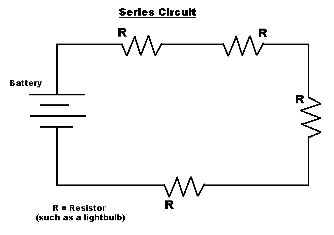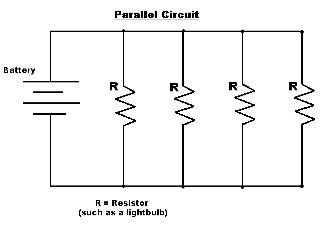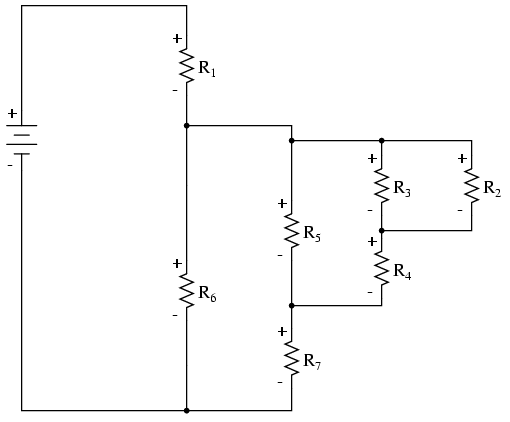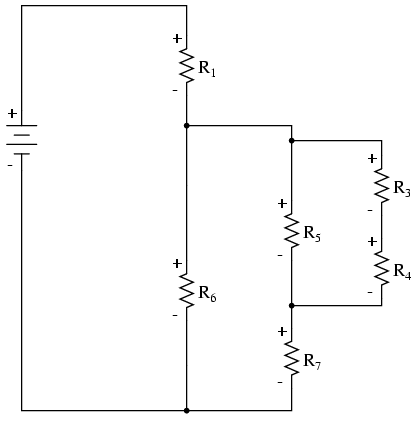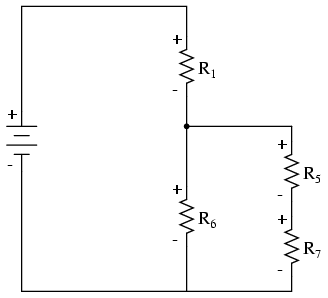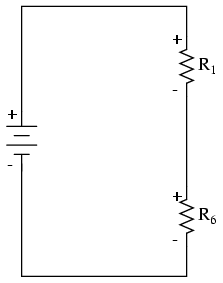Energy in a Circuit: Difference between revisions
No edit summary |
No edit summary |
||
| (11 intermediate revisions by the same user not shown) | |||
| Line 1: | Line 1: | ||
Claimed by | Claimed by ngoswami3 | ||
==Preface== | ==Preface== | ||
| Line 6: | Line 6: | ||
==Definitions== | ==Definitions== | ||
===Power=== | ===Power=== | ||
Power | Power is measured in watts, and in a circuit, it is the rate at which energy is converted from electrical energy to a different type of energy. | ||
<math> \mathbf{P} = </math> Power | |||
<math> \mathbf{P} = \mathbf{I} * \mathbf{V} </math> | |||
<math> \mathbf{P} = \frac{\mathbf{V}^2} {\mathbf{R}} </math> | |||
===Resistance=== | ===Resistance=== | ||
Resistance | Resistance is measured in ohms. It slows the flow of the charge and is the ratio of the voltage applied to the electrical current flowing through it. Examples include lights, fans, and any appliances within the circuit. The longer the wire, the greater its resistance. Total resistance is calculated differently depending on the type of circuit: series or parallel. | ||
<math> \mathbf{R} = </math> Resistance | |||
<math> \mathbf{R} = \frac {\mathbf{V}} {\mathbf{I}} </math> | |||
===Voltage=== | ===Voltage=== | ||
Voltage | Voltage, or electric potential, is measured in volts. It is the electrical potential energy per unit charge and, in reference to class problems, determines the brightness of a light bulb along with power. Voltage is calculated differently depending on the type of circuit: series or parallel. | ||
<math> \mathbf{V} = </math> Voltage | |||
<math> \mathbf{V} = \mathbf{I} * \mathbf{R} </math> | |||
===Current=== | ===Current=== | ||
Current | Current is measured in amperes. It is the energy that flows through the circuit and has different rules to its calculations depending on the type of circuit. | ||
<math> \mathbf{I} = </math> Current | |||
'''Ohm's Law''' | |||
<math> \mathbf{I} = \frac {\mathbf{V}} {\mathbf{R}} </math> | |||
==Series Circuits== | ==Series Circuits== | ||
A series circuit is when all the resistors within the circuit are on one path. There is one path leading from the power source, through the resistors, and back to the source. | A series circuit is when all the resistors within the circuit are on one path. There is one path leading from the power source, through the resistors, and back to the source. | ||
Total resistance in a series circuit is calculated by adding the resistance of all the resistors in series together. | Total resistance in a series circuit is calculated by adding the resistance of all the resistors in series together. | ||
<math> \mathbf{R}_{total} = \mathbf{R}_{1} + \mathbf{R}_{2} + \mathbf{R}_{3} + ... </math> | |||
The current is constant throughout the paths in series. | The current is constant throughout the paths in series. | ||
[[File:nseries.jpg]] | |||
==Parallel Circuits== | ==Parallel Circuits== | ||
A parallel circuit is when there is more than one path leading from the power source for the current to flow through. | A parallel circuit is when there is more than one path leading from the power source for the current to flow through. | ||
Total resistance in a parallel circuit is calculated by adding the inverse of each resistor in the parallel wires and then taking the inverse of the total. | Total resistance in a parallel circuit is calculated by adding the inverse of each resistor in the parallel wires and then taking the inverse of the total. | ||
<math> \frac {1} {\mathbf{R}_{total}} = \frac {1} {\mathbf{R}_{1}} + \frac {1} {\mathbf{R}_{2}} + \frac {1} {\mathbf{R}_{3}} + ... </math> | |||
When the paths of a parallel circuit branch off from the original path, the currents of those paths will always add up to the current of the original path. | When the paths of a parallel circuit branch off from the original path, the currents of those paths will always add up to the current of the original path. | ||
[[File:Parallel Circuit.jpeg]] | |||
==Calculation Tips== | |||
Most problems given to students are mixed circuits, and calculating the total resistance can be confusing. A straightforward way is to draw out the circuit and then slowly simplify it. Take the resistors in parallel to each other and calculate their total resistance. You now have one resistor on that same path with the resistance you just calculated. Take resistors in series to each other and calculate their total resistance, and now you have one resistor with the total resistance. Each time you do these steps. redraw the the simplified circuit. Doing this step-by-step will reduce your chances of error. | |||
[[File:finalcircuit.png]] | |||
<math> \frac {1} {\mathbf{R}_{3}} = \frac {1} {\mathbf{R}_{2}} + \frac {1} {\mathbf{R}_{3}} </math> | |||
[[File:finalcircuit_1.png]] | |||
Now you have resistors in series, so add them together: | |||
<math> \mathbf{R}_{4} = \mathbf{R}_{3} + \mathbf{R}_{4} </math> | |||
Combine the resistors in parallel: | |||
<math> \frac {1} {\mathbf{R}_{5}} = \frac {1} {\mathbf{R}_{4}} + \frac {1} {\mathbf{R}_{5}} </math> | |||
[[File:finalcircuit_2.png]] | |||
Now you have resistors in series, so add them together: | |||
<math> \mathbf{R}_{5} = \mathbf{R}_{5} + \mathbf{R}_{7} </math> | |||
Combine the resistors in parallel: | |||
<math> \frac {1} {\mathbf{R}_{6}} = \frac {1} {\mathbf{R}_{5}} + \frac {1} {\mathbf{R}_{6}} </math> | |||
[[File:finalcircuit_3.png]] | |||
These are your last resistors in series, so add them together to get the total resistance: | |||
<math> \mathbf{R}_{total} = \mathbf{R}_{1} + \mathbf{R}_{6} </math> | |||
Also, keep in mind the different rules that apply to the different types of circuits. Mixing up these rules are common mistakes students make in their calculations. | |||
If you think you have made an error, go back to your circuit and calculate the values (I,R,V,P) again. Once you have the values, check to make sure: | |||
1. The voltages are the same on their corresponding paths of the parallel circuits. | |||
2. The currents are the same on the main paths of the series circuits. | |||
3. The currents in a parallel circuit add up to the current of the main path they branched off from. | |||
==Connectedness== | ==Connectedness== | ||
# | #In middle school, I made a house with working appliances. It was such an enthralling experience, and I enjoyed making the circuits and figuring out which ones would work best. | ||
# | #I am a computer science major, but if I want to do into the devices thread, knowing how these circuits work would be beneficial. With that knowledge in addition to computer programming knowledge, I would be able to thoroughly understand the top-down making of the device. | ||
#Circuits are used all around us. From within our appliances to the outlets we plug them into, circuits are the basis of most technology we use today. You could apply circuits to almost any industry. | |||
==History== | ==History== | ||
The first battery was invented by Alessandro Volta in 1800. With this invention, circuits could now be made. Battery-powered circuits have a constant flow going in one direction, and it is called Direct Current (DC). The more efficient and modern circuit is the Alternating Current (AC). Sebastian Ferranti and Lord Kelvin worked together to create the early transformer on AC in 1882. In 1886, "the first full AC power system in the world is demonstrated using step up and step down transformers. The system was built by William Stanley and funded by Westinghouse." Nikola Tesla contributed to many big improvements to AC power. AC power became commercial in the late 1800s, and it has quickly grown to be the main way we transfer energy over long distances. | |||
== See also == | == See also == | ||
http://www.physicsbook.gatech.edu/Series_Circuits | |||
http://www.physicsbook.gatech.edu/Parallel_Circuits | |||
http://www.physicsbook.gatech.edu/Ohm%27s_Law | |||
===Further reading=== | ===Further reading=== | ||
Matter & Interactions, Vol. II: Electric and Magnetic Interactions, 4nd Edition by R. Chabay & B.Sherwood (John Wiley & Sons 2015) | |||
===External links=== | ===External links=== | ||
[http://www.scientificamerican.com/article/bring-science-home-reaction-time/] | [http://www.scientificamerican.com/article/bring-science-home-reaction-time/] | ||
[http://www.powermag.com/current-issue-powernews/] | |||
==References== | ==References== | ||
#http://hyperphysics.phy-astr.gsu.edu/hbase/electric/resis.html#c1 | |||
#http://www.allaboutcircuits.com/textbook/direct-current/chpt-7/re-drawing-complex-schematics/ | |||
#http://hyperphysics.phy-astr.gsu.edu/hbase/electric/ohmlaw.html | |||
#http://farside.ph.utexas.edu/teaching/302l/lectures/node61.html | |||
#http://www.physicsclassroom.com/class/circuits/Lesson-4/Parallel-Circuits | |||
#http://science.howstuffworks.com/environmental/energy/circuit3.htm | |||
#http://www.edisontechcenter.org/AC-PowerHistory.html | |||
#http://science.howstuffworks.com/environmental/energy/circuit3.htm | |||
[[Category:Which Category did you place this in?]] | [[Category:Which Category did you place this in?]] | ||
Latest revision as of 19:42, 5 December 2015
Claimed by ngoswami3
Preface
Energy in a circuit originates from the battery, and once the circuit is closed, it flows through the wires.
Definitions
Power
Power is measured in watts, and in a circuit, it is the rate at which energy is converted from electrical energy to a different type of energy.
[math]\displaystyle{ \mathbf{P} = }[/math] Power
[math]\displaystyle{ \mathbf{P} = \mathbf{I} * \mathbf{V} }[/math]
[math]\displaystyle{ \mathbf{P} = \frac{\mathbf{V}^2} {\mathbf{R}} }[/math]
Resistance
Resistance is measured in ohms. It slows the flow of the charge and is the ratio of the voltage applied to the electrical current flowing through it. Examples include lights, fans, and any appliances within the circuit. The longer the wire, the greater its resistance. Total resistance is calculated differently depending on the type of circuit: series or parallel.
[math]\displaystyle{ \mathbf{R} = }[/math] Resistance
[math]\displaystyle{ \mathbf{R} = \frac {\mathbf{V}} {\mathbf{I}} }[/math]
Voltage
Voltage, or electric potential, is measured in volts. It is the electrical potential energy per unit charge and, in reference to class problems, determines the brightness of a light bulb along with power. Voltage is calculated differently depending on the type of circuit: series or parallel.
[math]\displaystyle{ \mathbf{V} = }[/math] Voltage
[math]\displaystyle{ \mathbf{V} = \mathbf{I} * \mathbf{R} }[/math]
Current
Current is measured in amperes. It is the energy that flows through the circuit and has different rules to its calculations depending on the type of circuit.
[math]\displaystyle{ \mathbf{I} = }[/math] Current
Ohm's Law [math]\displaystyle{ \mathbf{I} = \frac {\mathbf{V}} {\mathbf{R}} }[/math]
Series Circuits
A series circuit is when all the resistors within the circuit are on one path. There is one path leading from the power source, through the resistors, and back to the source.
Total resistance in a series circuit is calculated by adding the resistance of all the resistors in series together.
[math]\displaystyle{ \mathbf{R}_{total} = \mathbf{R}_{1} + \mathbf{R}_{2} + \mathbf{R}_{3} + ... }[/math]
The current is constant throughout the paths in series.
Parallel Circuits
A parallel circuit is when there is more than one path leading from the power source for the current to flow through. Total resistance in a parallel circuit is calculated by adding the inverse of each resistor in the parallel wires and then taking the inverse of the total.
[math]\displaystyle{ \frac {1} {\mathbf{R}_{total}} = \frac {1} {\mathbf{R}_{1}} + \frac {1} {\mathbf{R}_{2}} + \frac {1} {\mathbf{R}_{3}} + ... }[/math]
When the paths of a parallel circuit branch off from the original path, the currents of those paths will always add up to the current of the original path.
Calculation Tips
Most problems given to students are mixed circuits, and calculating the total resistance can be confusing. A straightforward way is to draw out the circuit and then slowly simplify it. Take the resistors in parallel to each other and calculate their total resistance. You now have one resistor on that same path with the resistance you just calculated. Take resistors in series to each other and calculate their total resistance, and now you have one resistor with the total resistance. Each time you do these steps. redraw the the simplified circuit. Doing this step-by-step will reduce your chances of error.
[math]\displaystyle{ \frac {1} {\mathbf{R}_{3}} = \frac {1} {\mathbf{R}_{2}} + \frac {1} {\mathbf{R}_{3}} }[/math]
Now you have resistors in series, so add them together:
[math]\displaystyle{ \mathbf{R}_{4} = \mathbf{R}_{3} + \mathbf{R}_{4} }[/math]
Combine the resistors in parallel:
[math]\displaystyle{ \frac {1} {\mathbf{R}_{5}} = \frac {1} {\mathbf{R}_{4}} + \frac {1} {\mathbf{R}_{5}} }[/math]
Now you have resistors in series, so add them together:
[math]\displaystyle{ \mathbf{R}_{5} = \mathbf{R}_{5} + \mathbf{R}_{7} }[/math]
Combine the resistors in parallel:
[math]\displaystyle{ \frac {1} {\mathbf{R}_{6}} = \frac {1} {\mathbf{R}_{5}} + \frac {1} {\mathbf{R}_{6}} }[/math]
These are your last resistors in series, so add them together to get the total resistance:
[math]\displaystyle{ \mathbf{R}_{total} = \mathbf{R}_{1} + \mathbf{R}_{6} }[/math]
Also, keep in mind the different rules that apply to the different types of circuits. Mixing up these rules are common mistakes students make in their calculations.
If you think you have made an error, go back to your circuit and calculate the values (I,R,V,P) again. Once you have the values, check to make sure:
1. The voltages are the same on their corresponding paths of the parallel circuits.
2. The currents are the same on the main paths of the series circuits.
3. The currents in a parallel circuit add up to the current of the main path they branched off from.
Connectedness
- In middle school, I made a house with working appliances. It was such an enthralling experience, and I enjoyed making the circuits and figuring out which ones would work best.
- I am a computer science major, but if I want to do into the devices thread, knowing how these circuits work would be beneficial. With that knowledge in addition to computer programming knowledge, I would be able to thoroughly understand the top-down making of the device.
- Circuits are used all around us. From within our appliances to the outlets we plug them into, circuits are the basis of most technology we use today. You could apply circuits to almost any industry.
History
The first battery was invented by Alessandro Volta in 1800. With this invention, circuits could now be made. Battery-powered circuits have a constant flow going in one direction, and it is called Direct Current (DC). The more efficient and modern circuit is the Alternating Current (AC). Sebastian Ferranti and Lord Kelvin worked together to create the early transformer on AC in 1882. In 1886, "the first full AC power system in the world is demonstrated using step up and step down transformers. The system was built by William Stanley and funded by Westinghouse." Nikola Tesla contributed to many big improvements to AC power. AC power became commercial in the late 1800s, and it has quickly grown to be the main way we transfer energy over long distances.
See also
http://www.physicsbook.gatech.edu/Series_Circuits
http://www.physicsbook.gatech.edu/Parallel_Circuits
http://www.physicsbook.gatech.edu/Ohm%27s_Law
Further reading
Matter & Interactions, Vol. II: Electric and Magnetic Interactions, 4nd Edition by R. Chabay & B.Sherwood (John Wiley & Sons 2015)
External links
References
- http://hyperphysics.phy-astr.gsu.edu/hbase/electric/resis.html#c1
- http://www.allaboutcircuits.com/textbook/direct-current/chpt-7/re-drawing-complex-schematics/
- http://hyperphysics.phy-astr.gsu.edu/hbase/electric/ohmlaw.html
- http://farside.ph.utexas.edu/teaching/302l/lectures/node61.html
- http://www.physicsclassroom.com/class/circuits/Lesson-4/Parallel-Circuits
- http://science.howstuffworks.com/environmental/energy/circuit3.htm
- http://www.edisontechcenter.org/AC-PowerHistory.html
- http://science.howstuffworks.com/environmental/energy/circuit3.htm
